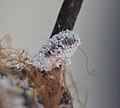| Apefly | |
|---|---|
 | |
| Upperside | |
 | |
| Underside, Kerala, India | |
| Scientific classification | |
| Kingdom: | Animalia |
| Phylum: | Arthropoda |
| Class: | Insecta |
| Order: | Lepidoptera |
| Family: | Lycaenidae |
| Genus: | Spalgis |
| Species: | S. epius |
| Binomial name | |
| Spalgis epius (Westwood, 1851) | |
| Synonyms | |
| |
Spalgis epius, [1] commonly known as the apefly, is a small species of butterfly found in the Indomalayan realm that belongs to the lycaenids or blues family. [2] [3] It gets its name from the supposed resemblance of its pupa to the face of an ape.






